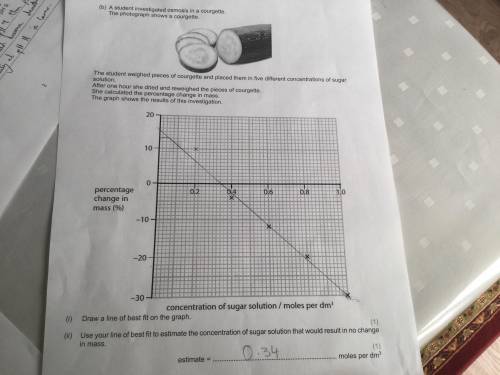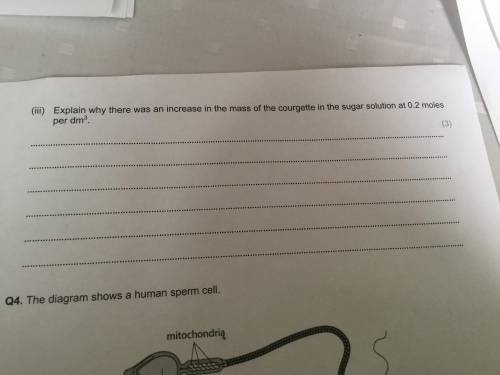
The student weighed pieces of courgette and placed them in five different concentrations of sugar solution.
After one hour she dried and reweighed the pieces of courgette.
She calculated the percentage change in mass.
the concentration of sugar solution that would result in no change in mass is 0.4 moles per dm3
Explain why there was an increase in the mass of the courgette in the sugar solution at 0.2 moles per dm3.
Please some one answer this



Answers: 1
Another question on Biology

Biology, 21.06.2019 17:50
How did the research presented in the article affect scientists' understanding of the evolution of eukaryotes
Answers: 3

Biology, 22.06.2019 00:30
At which location in earth’s interior does the top density continue to increase as thickness decreases?
Answers: 1

Biology, 22.06.2019 00:30
Experiments in environmental toxicology can sometimes be manipulative experiments in which the researcher actively chooses and manipulates the independent variable. in hunt's study, for example, dosages of bpa were manipulated and the effects were measured. in manipulative studies, the researcher controls all the other variables in the experiment, so any health effects observed in the test subjects can be attributed to differences in the independent variable. in other cases, researchers use natural experiments in which the dependent variable (typically a measure of organism health) is measured under differing contexts that are not manipulated. say, for example, that an accidental chemical spill contaminates five ponds. to determine the possible effects of the toxic chemical on frogs, a researcher could compare the hatching rate of frog eggs laid in those five ponds to the hatching rate of eggs laid in five uncontaminated ponds nearby. this would be an example of a natural experiment because concentrations of the toxic chemical in the ponds were not controlled by the experimenter, but rather resulted from the chemical spill. drag type of experiment on the left to the example of experiment on the right. blood concentrations of bpa in college students are compared to their recent manipulative consumption of canned food items 2. the feeding behavior of fish in streams that receive acidic runoff from strip mines is compared to the feeding behavior of fish in unaffected streams. the deformity rate in baby birds from nests in pesticide-sprayed fields is compared to the deformity rate in birds from nests in unsprayed fields 4 tumor development is compared in mice exposed to five dosages of a known carcinogen in the laboratory foraging activity levels are compared in tadpoles exposed to four concentrations of toxic metals in the laboratory. growth of corn plants is compared in field plots sprayed with three different dosage: s of weed killer 7 bpa concentrations in the urine of people with diabetes are compared to bpa concentrations in the urine of people without diabetes - natural; manipulative
Answers: 1

Biology, 22.06.2019 12:00
If the dimensions of a cube-shaped cell with a length,height, and width of 1 micrometer were to double, what would be the cell's new ratio of surface area to volume? a.3 to 1 b.4 to 3 c.1 to 2 d1 to 6
Answers: 1
You know the right answer?
The student weighed pieces of courgette and placed them in five different concentrations of sugar so...
Questions

History, 08.03.2021 20:50


Mathematics, 08.03.2021 20:50





Biology, 08.03.2021 20:50


SAT, 08.03.2021 20:50

Mathematics, 08.03.2021 20:50

Mathematics, 08.03.2021 20:50

Chemistry, 08.03.2021 20:50





Mathematics, 08.03.2021 20:50

Mathematics, 08.03.2021 20:50

Spanish, 08.03.2021 20:50



